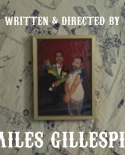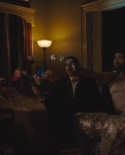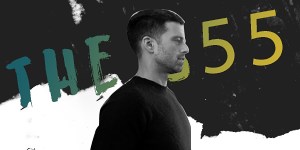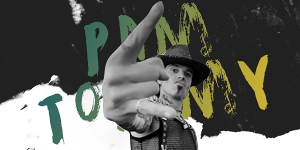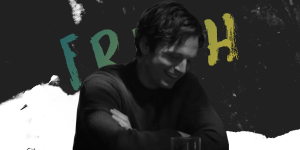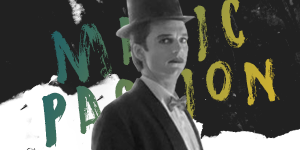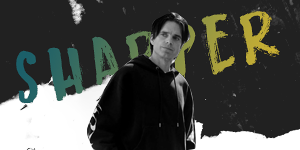- By manon
- On June 11, 2022
- With 0 Comments
- Filed Under gallery, interview, photos, photoshoot, portraits, screen captures, video

Some days ago, Sebastian Stan talked about method acting in a preview of the LA Times Envelope Drama Roundtables. Yesterday (June 10th) the full interviw came out, featuring Sebastian talking with Melanie Lynskey, Adam Scott, Jin Ha, Rhea Seehorn and Kaitlyn Dever. You can watch the full interview right below and find all the screen captures of Sebastian Stan from this interview in the gallery.
Photoshoots & Portraits > 2022 > LA Times | Emmy Drama Roundtable
LA Times | If the Emmy Drama Roundtable proves anything, it’s that even the stars of TV’s buzziest shows are familiar with the indignities of the working stiff.
When asked, in regard to his role in “Severance,” if there’s a job on his résumé he’d prefer to forget, Adam Scott said even his less memorable work moved him forward. But, he noted, “My first job ever, I was in the background for a Tia Carrere music video. … It was in the fall of 1993 and it was at a coffeehouse and I had a beret and I was drinking coffee. I actually can’t find it on YouTube, so I guess the world has forgotten about it.”
Rhea Seehorn, starring to broad acclaim in the final season of “Better Call Saul,” said, “I have many auditions I’d like to forget.”
“I would forget every audition if I could,” said Melanie Lynskey, who stars in Showtime’s creepy survival tale “Yellowjackets.”
Sebastian Stan, in the process of obliterating his Marvel superhero image with a transformative turn in “Pam & Tommy,” used to submit elaborate VHS audition tapes.
I think my first big movie job came off of a tape,” he said. “And I remember I was really cool about it because I had a cigarette. You couldn’t really do that in the auditions. And this particular time it worked because the producer smoked cigarettes and he really was just …”
“‘Someone that smokes cigarettes is right for our cast,’” Scott interjects.
Kaitlyn Dever of “Dopesick” recalled one of her first jobs, at age 14, on Scott’s show, “Party Down”: “I played a girl named Escapade. … I sang ‘The Star-Spangled Banner’ in front of the entire cast.”
Jin Ha, who holds degrees from Columbia and NYU and is currently featured speaking three languages (four dialects) in “Pachinko,” said, “There’s a babysitting job I wish I could sever [from] my brain. It was just once because they never asked me back. It was two young girls and I made bacon for them and it did not go well. I poured the hot oil into the trash bin, which must have melted.”
Here, in excerpts from their sit-down with The Times (edited for length and clarity), the six actors explain the inner workings of their characters, learning from teachers, collaborating with directors and watching themselves onscreen.
Many of you have what I’d call strong internal conflicts in your roles. Jin, for your character in “Pachinko” to seal this big deal, you’re going to have to manipulate an elderly woman and enlist your wonderful grandmother.
Jin Ha: I’ve been thrust into this position of responsibility as the second or third generation of this family that’s gone through so much. What are the expectations that are put upon that generation? The first generation that has opportunity available to them, the weight of that expectation can be heavy. What was the line from “Evan Hansen”?
Kaitlyn Dever [costar of “Dear Evan Hansen”]: Oh …
Ha: “We wear it well, but it doesn’t mean it’s not heavy.”
Dever: That’s it.
Ha: It’s about those internal struggles for Solomon of, “I am Korean and I was born and raised in Japan, therefore I am also Japanese. I went to school and worked in America, so I am also American in that way.” And the way that he tries to straddle those three identities is a lot of the source of his tension.
[Seehorn’s character] Kim, we can see every step of the way being charmed by what Jimmy does and then starting to buy into it herself. Are those arcs as well mapped out as they seem over six seasons?
Rhea Seehorn: There is an architecture to being a prequel; we have some mileposts that have to be hit. But no, they’re not mapped out. [The writers] love to paint themselves into corners and figure out how to get out.
Adam Scott: That’s crazy.
Seehorn: The famous Krysten Ritter scene in “Breaking Bad” when Walt lets her choke on her own vomit and somebody has to come and clean it up. … There is only a Mike Ehrmantraut character at all in that universe because they didn’t plan ahead. Bob Odenkirk was busy on a film; it was supposed to be Saul.
[To Lynskey] Do you get told the whole arc and where your character is going?
Melanie Lynskey: I like to know where something’s going. There were a few moments in “Yellowjackets” where I wanted to fall apart a little bit, but I knew there was a moment, like right at the end, where she was able to fall apart.
Seehorn: You don’t want to step on that.
Lynskey: I also love improvising. I improvise so much on “Yellowjackets.” There’s one episode where I do this whole speech about what Shauna was thinking would happen during college and in her life, and I improvised the whole thing.
Dever: Did you ever study improv?
Lynskey: I never studied acting at all, but when I was younger, there was a local theater teacher who would host these classes on Friday night. And she’d just sit there, chain smoking. She was this elderly woman in New Plymouth, New Zealand. Yeah, [smoking], “That’s the key, guys. [In a sandpaper voice] That was great. That wasn’t so good. I didn’t believe that.”
Sebastian Stan: You guys ever see that YouTube video of Stella Adler? She’s got a glass of wine, first of all. Then they do the scene and she grabs her hair and she’s like, “It’s not about the money. It’s not about the fame, it’s about acting!”She’s so dramatic and she’s like, “It’s suffering. That’s the life of the…” I’m not doing it justice.
I think you have to be really careful. I went to a conservatory program, and stuff didn’t click in for me until 10 years later because I think you’re just too young.
[To Dever] For you [in “Dopesick”], that inner conflict has to do with addiction. It makes you do things you know are wrong, that you don’t want to do.
Dever: The hardest part, I think, was understanding how it affects someone emotionally. [So much online is] just the side effects — it’s usually just these lists I kept running into. I met someone on set that shared a similar experience to my character. He was so, so important to my process and developing the character.
One of the bigger things too is keeping track of the level of withdrawal that she goes through. Because we’re shooting TV, we were going so out of order. I actually created a spreadsheet, Google Docs. I don’t actually how to work Google Docs, but my sister helped me. So, every time I would do a scene, I would write in the little box so I could keep track of where she was emotionally.
Scott: It was incredible performance. Unbelievable.
Ha: We had two directors for [“Pachinko”] — There were two blocks, but they were shooting concurrently. So I would go shoot with Justin [Chon] in the morning and then in the afternoon, I’d switch clothes and jump to a different episode to work with Kogonada.
Scott: We did the same thing on “Severance,” too.
Ha: So, it makes it hard for me to see past … I mean, it’s also probably just the actor voice in my brain not being able to shut off and being like, “What are you doing with your hands? Just relax your face.”
Seehorn: Can you guys watch yourselves?
Lynskey: That’s torture.
Seehorn: I’m a fan of many of the shows I’ve been in but I can’t enjoy it ’til the second watch. The first watch is like, “And then she came back. It was going well.”
Stan: That’s the worst.
Lynskey: I watch it one time so I know how to talk about it when I have to talk about it … and then I will never see it again.
Ha: Because it’s uncomfortable?
Lynskey: Because it’s my horrible face. … [laughter] I cannot stand watching myself. I’m so self-conscious.
[To Scott] Did you have trouble keeping your head straight about [the two versions of the same character you play in “Severance”]?
Scott: We were doing the same thing, where it would be Episode 1 and then later in the day, Episode 7. And [director Ben Stiller] told me, “I visited Michael Keaton on the set of ‘Multiplicity’ back in the day, and in his trailer, he had these charts up on the wall, because he was playing a bunch of different characters for that movie.” He had a different chart for each character so he knew exactly where they were.
Dever [who co-starred with Keaton in “Dopesick”]: Wow. He never told me that. That’s so cool.
Seehorn: He didn’t ask you about your Google Doc? [laughter]
Scott: And I didn’t do that [laughter] because it was the pandemic in New York. I was like, “Do I go get poster boards? How am I going to do this?” But what I did do is just try and map out on the opposite page of my script the two arcs and where they are throughout the season and also how they affect each other — how what’s happening inside [the company] affects him on the outside.
Sebastian, in the second episode [of “Pam & Tommy”] where they just lose their minds for each other, we are out of our minds with you.
Stan: A lot of that for me was just trusting [director] Craig Gillespie because I’d worked with him before … That was him having already picked all his shots and so much of it was in cameras being attached to us and him trailing us and music and things. And as I’ve gotten older and worked a little bit more, I’ve become much better at paying attention to the monitor and what’s going on because then I find that it can help lift you. You don’t have to do all the work sometimes if you just understand how they’re doing it.
Ha: Do you mean in terms of what the framing will be?
Stan: I love watching the stand-in or the camera rehearsal, because then you go, “Oh, when they get to that angle, that’ll be a perfect moment to turn into the thing.” It’s weirdly technical, but it helps sometimes.
Rhea, you just made your directorial debut on “Better Call Saul.” What do you guys feel like you get from a director who’s got that much experience as an actor? What do you think you brought to it?
Seehorn: It’s not just that I was an actor directing; you have somebody that knows the show. Everyone is aware that I understand the tone and I deeply understand their character arcs. But I made it a point to ask people about their process. I mean, there’s people like Giancarlo Esposito who’s been on Broadway since he was a child that I haven’t been in scenes with. Does he want to talk about the scene? Does he want to be left alone?
Stan: [Actor] Lake Bell directed some of our stuff and she was great. She really doesn’t miss the little looks and the moments.
Scott: Actors directing really understand that feeling and how vulnerable or exposed you feel sometimes, and when someone’s insensitive to that, it’s a bummer. I’ve found, getting older and working more and more, that that’s so important, just to have that trust in that person. Because in the moment often I have no perspective whatsoever.
Seehorn: And to have someone tell you when it’s reading false.
Scott: Or if you do something that you know was lame and they come up and just tell you how great it was, you know they’re not watching.
Lynskey: I hate compliments in general. It just feels like a waste of time. … People doing surgery together are not like, “Oh my God, such a great incision.” You’re working.
Dever: Working with certain directors who have only been on their set is a really interesting thing because working with Olivia Wilde [on “Booksmart”], she has been on so many different sets, worked with so many different types of directors, and then has been able to gather the good and bad and make the perfect formula.
Lynskey: A good director is like a good therapist, where they’re able to put something to you in a way where it unlocks something in your brain and you see it a bit differently. And you’re like, “Oh my God, of course.” Or they tell you something about your character that hasn’t quite opened up to you yet. It’s hard for me when somebody’s very technical or feels like they don’t trust me and tells me a lot of stuff before they’ve even seen me do it. I get so guarded.
Stan: I had a director one time who was telling me acting notes and I kept pushing back because I was like, “This is not making sense to what the scene’s about.” And finally they were like, “Well, I just have this crane shot. I just want you to end up here and I want him to end up behind you.” And I go, “Why didn’t you just say that? You put me through this thing where you were making me feel like my f— instincts were not on point.” And then trust was gone.
Lynskey: When someone’s like, “And then you walk up to her because you want to be really close and it’s very —” and I’m like, “Oh, I don’t know. That feels like a lot.” It’s always that. “Well, I have a nice two shot …” [laughter of recognition]
Ha: Exactly. Explain that to us and we’ll get it.
 Welcome to Adoring Sebastian Stan, your fansource about everything related to the Romanian-American actor Sebastian Stan. Sebastian is most known for his role as James Buchanan "Bucky" Barnes / The Winter Soldier on the Marvel Cinematic Universe franchise. He also stared in the famous tv series 'Gossip Girl' and Once Upon a Time as well as in the movies 'The Martian', 'I, Tonya', 'The Devil All the Time' and many more! I aim to provide you the best and fastest fansource about Sebastian Stan with regular news, photos, videos and any other kind of updates related to the actor. Enjoy your stay!
Welcome to Adoring Sebastian Stan, your fansource about everything related to the Romanian-American actor Sebastian Stan. Sebastian is most known for his role as James Buchanan "Bucky" Barnes / The Winter Soldier on the Marvel Cinematic Universe franchise. He also stared in the famous tv series 'Gossip Girl' and Once Upon a Time as well as in the movies 'The Martian', 'I, Tonya', 'The Devil All the Time' and many more! I aim to provide you the best and fastest fansource about Sebastian Stan with regular news, photos, videos and any other kind of updates related to the actor. Enjoy your stay! 
